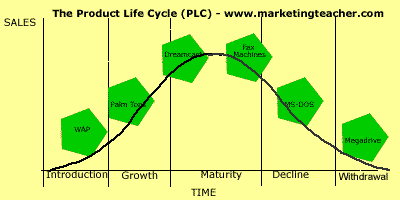The Product Life Cycle (PLC)
Here’s a recap of the Product Life Cycle (PLC). It is followed by the PLC answer (below).
Introduction.
The need for immediate profit is not a pressure. The product is promoted to create awareness. If the product has no or few competitors, a skimming price strategy is employed. Limited numbers of product are available in few channels of distribution.
Decline.
At this point there is a downturn in the market. For example more innovative products are introduced or consumer tastes have changed. There is intense price-cutting and many more products are withdrawn from the market. Profits can be improved by reducing marketing spend and cost cutting.
Here are the products plotted in the PLC. You may disagree with some of the positioning. However, the exercise demonstrates the way in which marketers would use such a tool.
Answer:

Growth
Competitors are attracted into the market with very similar offerings. Products become more profitable and companies form alliances, joint ventures and take each other over. Advertising spend is high and focuses upon building brand. Market share tends to stabilise.
Maturity.
Those products that survive the earlier stages tend to spend longest in this phase. Sales grow at a decreasing rate and then stabilise. Producers attempt to differentiate products and brands are key to this. Price wars and intense competition occur. At this point the market reaches saturation. Producers begin to leave the market due to poor margins. Promotion becomes more widespread and use a greater variety of media.
